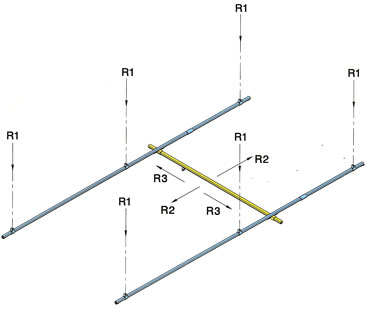|
|
|
|
|
|
|
Rigid
Runways Provide for Superior
Positioning of Loads |
|
Calculating
Applied Forces to the
Supporting Structure |
|
|
This
illustration shows the relative position and the
direction of forces that a ceiling-mounted bridge crane
applies to its supporting structure. Before installing any
crane system, it’s critical that you determine whether
your building will safely support the loads. |
|
Work Station Bridge Cranes
are installed so that
the runways are rigid. They do not move laterally
or longitudinally. In addition, the floating end
trucks with horizontal wheels prevent binding. The
combination of these design features results in
unmatched ease of positioning and ease of movement.
The bridge travels smoothly down the runways, and
movement is unvarying along the way, no matter
where a load is positioned on the bridge. This allows
superior load positioning.
|
|
|
Loads
applied to the support structure can be
determined using the following formulas, where: |
|
|
|
|
|
|
|
 |
|
|
Another
advantage of rigid runways is that they can
be reinforced (trussed “S" series), so they are useful
where long spans are required. This eliminates the
need for expensive intermediate support stringers,
and it lowers overall installation cost. |
|
|
|
| Mixed
Capacity Bridge Crane Systems: |
|
|
|
Reduced
bridge dead weight equals better
ergonomic solutions. |
|
|
|
Mixed-capacity
systems allow multiple lower capacity
bridges to be used on higher capacity runways, provided
the equivalent center loads (ECL) are verified at the
factory to ensure that runways and hangers are not
overloaded. For example, using mixed-capacity end
trucks, four 500 lb. bridges (utilizing 500 series rail)
can be hung from a 2000 lb. runway, allowing side-by-
side use of all four bridges without overloading the
system. By mixing bridges of various sizes and capacities,
mixed-capacity systems offer reduced bridge
dead weight, easier movement, and reduced cost. |
|
|
|
|
|
|
|
|
R1
= vertical load applied by support hanger (lb.) |
|
R2
= longitudinal load applied by movement of the
crane to each runway (lb.) |
|
R3
= lateral force applied by movement of the trolley
and load to each runway (lb.) |
|
L1
= distance between support centers (ft.) |
|
|
(NOTE:
If there are only 2 supports/runway,
L1= L1 x 0.5) |
| What
is meant by Rated Capacity? |
|
|
|
The
rated capacity is the live load that can be lifted
by the crane system. The design load for the crane
system is based on the rated capacity plus 15% for
the weight of the hoist and trolley (capacity x 1.15)
and an additional 25% for impact (capacity x 1.25)
for a total design of capacity x 1.4 (Note, 25% impact
factor is good for hoist speeds up to 50 f.p.m.). For
example, a 1000 lb. Crane allows you to pick
up a 1000 lb. load, provided the hoist weighs 150 lb.
or less and the hoist speed is less than 50 feet per
minute. |
|
|
L4
= bridge span: center line distance between
runways (ft.) |
|
P
= live load capacity (lb.) |
|
1.4
= design factor (see description below) which
includes 25% for impact and 15% for assumed hoist
and trolley weight |
|
W
= weight per foot of runway (lb./ft.) See installation
guide below |
|
w
= weight per foot of bridge (lb./ft.) See installation
guide below |
|
R1
= 1.4 x P + (W x L1) + (w x L4) |
|
|
Design
load for deflection calculations is based on the
rated capacity plus 15% for the weight of the hoist and
trolley (capacity x 1.15). Under no conditions should the
crane be loaded beyond its rated capacity. Gorbel Work
Station Cranes meet or exceed the ANSI B30.11
specifications for underhung bridge cranes. |
|
|
|
|
|
2
|
|
|
R2
= ((1.15 x P) + (w x L4) )x .10 |
|
|
2
|
|
|
|
|
R3
= 1.15 x P x .20 |
|
|
|
|
|
|
|
WARNING:
Equipment described in this brochure is not
designed for, and should not be used for, lifting, supporting,
or transporting humans. Failure to comply with any one of the
limitations noted can result in serious bodily injury and/or
property damage. |
|
|


